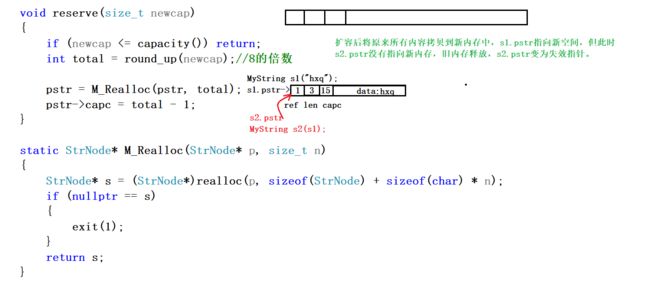C++ 8:MyString(柔性数组,写时拷贝)
文章目录
- 1. 柔性数组
-
- 1.1 定义
- 1.2 用途
- 1.3 用法
- 1.4 缺点
- 2. 写时拷贝
-
- 2.1 定义
- 2.2 特点和实现
- 3. MyString
-
- 3.1 内存释放产生失效指针
- 3.2 代码优化
- 3.3 重载运算符
- 3.4 +=运算符重载代码详解
- 3.5 解决自赋值问题
-
- 3.5.1 自链接
- 3.5.2 运行结果
- 3.6 代码实现
1. 柔性数组
1.1 定义
数组大小声明为0,或者不给出大小,称之为柔性数组。
注意:全局数组和局部数据不能这样定义
柔性数组是一种数组大小待定的数组。在c语言中,可以使用结构体产生柔性数组,结构体的最后一个元素可以是大小未知的数组。
data是标识符,不占用存储空间。
//柔性数组
struct StrNode
{
int ref;//引用个数
int len;//字符串长度
int size;//字符串空间大小
char data[];
//char data[0];
};
1.2 用途
长度为0的数组主要是为了满足长度可变的结构体,只能在结构体最后声明。
1.3 用法
在一个结构体的最后,声明一个长度为0的数组。就可以使得这个结构体是可变长的。对于编译器来说。此时长度为О的数组并不占用空间,因为数组名本身不占空间,它只是一个偏移量,数组名这个符号本身代表了一个不可修改的地址常量。但对于这个数组的大小,我们可以进行动态分配。
注意︰如果结构体是通过calloc、malloc或 realloc等动态分配方式生成,在不需要时要释放相应的空间。优点︰比起在结构体中声明一个指针变量、再进行动态分配的办法,这种方法效率要高。因为简单。
1.4 缺点
在结构体中,数组为О的数组必须在最后声明,在设计结构体类型有一定限制。
2. 写时拷贝
2.1 定义
写时拷贝就是在写的时候(即改变字符串的时候)才会真正的开辟空间拷贝(深拷贝),如果只是对数据的读时,只会对数据进行浅拷贝。
2.2 特点和实现
-
写时拷贝:引用计数器的浅拷贝,又称延时拷贝
-
写时拷贝技术是通过"引用计数"实现的,在分配空间的时候多分配4个字节,用来记录有多少个指针指向块空间,当有新的指针指向这块空间时,引用计数加一,当要释放这块空间时,引用计数减一(假装释放),直到引用计数减为0时才真的释放掉这块空间。当有的指针要改变这块空间的值时,再为这个指针分配自己的空间(注意这时引用计数的变化,旧的空间的引用计数减一,新分配的空间引用计数加一。

3. MyString
3.1 内存释放产生失效指针
3.2 代码优化
优化前
void reserve(size_t newcap)
{
if (newcap <= capacity()) return;
int total = round_up(newcap);//8的倍数
//解决空指针问题
if (nullptr == pstr || pstr->ref == 1)
{
int n = size();
if (nullptr == pstr)
{
pstr = M_Realloc(pstr, total);
pstr->data[0] = '\0';
}
else
{
pstr = M_Realloc(pstr, total);
}
pstr = M_Realloc(pstr, total);
pstr->capc = total - 1;
}
else
{
StrNode* newdata = M_Malloc(total);
newdata->ref = 1;
newdata->capc = total - 1;
newdata->len = pstr->len;
strcpy_s(newdata->data, total, pstr->data);
pstr->ref -= 1;
pstr = newdata;//指向新空间
}
}
优化后
//增容函数(对象共享字符串可以增容)
void reserve(size_t newcap)
{
if (newcap <= capacity()) return;
int total = round_up(newcap);//8的倍数
//解决空指针问题
if (nullptr == pstr || pstr->ref == 1)
{
StrNode* newdata = M_Realloc(pstr, total);
if (nullptr == pstr)
{
newdata->ref = 1;
newdata->len = 0;
newdata->data[0] = '\0';
}
newdata->capc = total - 1;
pstr = newdata;
}
else
{
StrNode* newdata = M_Malloc(total);
newdata->ref = 1;
newdata->capc = total - 1;
newdata->len = pstr->len;
strcpy_s(newdata->data, total, pstr->data);
pstr->ref -= 1;
pstr = newdata;//指向新空间
}
}
3.3 重载运算符
3.4 +=运算符重载代码详解
MyString& operator+=(const MyString& cx)
{
if (pstr == nullptr)
{
*this = cx;
return *this;
}
if (cx.pstr == nullptr)
{
return *this;
}
if (pstr->ref > 1)
{
int n = size() + cx.size();
if (0 == n) return *this;
const char* pa = this->c_str();
const char* pb = cx.c_str();//获取柔性数组地址
StrNode* newdata = AddString(pa, pb, n);
pstr->ref -= 1;
pstr = newdata;
}
else
{
//若容量足够,则直接进行扩容
if (pstr->capc >= pstr->len + cx.size())
{
strcat_s(pstr->data, pstr->capc, cx.pstr->data);
}
//若容量不足,则重新申请空间进行转移
else
{
int n = this->pstr->len + cx.size();//总长度
const char* pa = this->c_str();
const char* pb = cx.c_str();
StrNode* newdata = AddString(pa, pb, n);
clear();
pstr = newdata;
}
}
return *this;
}
优化后
MyString& operator+=(const MyString& cx)
{
if (pstr == nullptr)
{
*this = cx;
return *this;
}
if (cx.pstr == nullptr)
{
return *this;
}
if (pstr->ref == 1 && pstr->capc >= pstr->len + cx.size())
{
strcat_s(pstr->data, pstr->capc, cx.pstr->data);
}
else
{
int n = this->pstr->len + cx.size();//总长度
const char* pa = this->c_str();
const char* pb = cx.c_str();
StrNode* newdata = AddString(pa, pb, n);
clear();
pstr = newdata;
}
return *this;
}
3.5 解决自赋值问题
3.5.1 自链接
3.5.2 运行结果
3.6 代码实现
#includerealloc函数使用
strcpy函数使用
strcat函数使用







